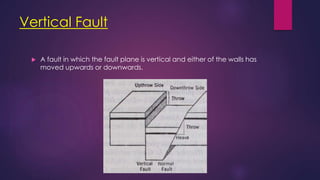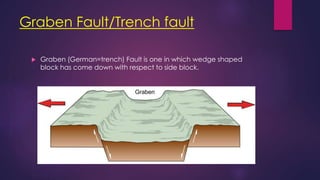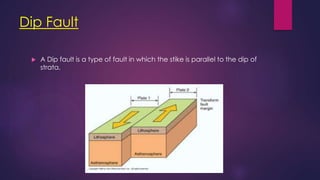Classification of Faults
- 1. FAULTS BY: PRAVEEN.S.K (42) PREMA.M (43) RAHILA.M (44)
- 2. What is a Fault? Faults are fractures along which movement of one block with respect to others has taken place. This movement may vary from a few centimeters to many kilometers depending on stresses and resistance offered by the rocks.
- 3. Parts of a Fault
- 4. Classification of Faults: Normal Fault A fault in which hanging wall has apparently come down with respect to the foot wall is termed a Normal Fault.
- 5. Reverse Fault This type of fault in which the hanging wall appears to have moved up with respect to the foot wall and dips at the angle more than 45 degrees.
- 6. Thrust Fault This is a type of reverse faults in which the hanging wall has moved up with respect to footwall and the fault dip at the angle below 45 degrees
- 7. Vertical Fault A fault in which the fault plane is vertical and either of the walls has moved upwards or downwards.
- 8. Horst Fault Horst (German = up throw) fault is one in which wedge shaped block has gone up with respect to the side blocks.
- 9. Graben Fault/Trench fault Graben (German=trench) Fault is one in which wedge shaped block has come down with respect to side block.
- 10. Dip Fault A Dip fault is a type of fault in which the stike is parallel to the dip of strata.
- 11. Strike Fault A strike fault is the one whose strike is parallel to the strike of the strata.
- 12. Parallel Faults A series of faults running more or less parallel to one another and hading in the same direction.
- 13. Step Fault Step fault is a type of parallel fault where down throw is all in the same direction a it gives a step like arrangement.












